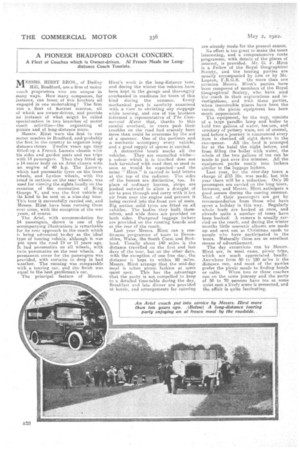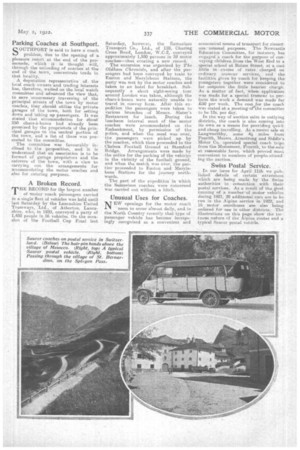A PIONEER BRADFORD COACH CONCERN.
Page 26

Page 27

If you've noticed an error in this article please click here to report it so we can fix it.
A Fleet of Coaches which is Owner-driven. Al Fresco Meals for Longdistance Coach Tourists.
MESSRS. HIRST BROS., of Dudley Hill, Bradford, are a firm of motor coach proprietors who arc unique in ninny ways. How many companies, for instance, can boast of live brothers all engaged in one undertaking? The firm run a fleet of _Lanier coaches, all of which are owner-driven, and provide an instance of what might be called specialization in two branches of motor coach activities—the organizing of picnics and of long-distance tours.
Messrs. Hirst were the first to run motor coaches in Bradford, anibprobably the first in the country to organize longdistance ttours Twelve years ago they littedtup a French Lacoste chassis with tin sides and garden seats and rate trips with 14 passengers. Then they fitted up a 14-seater body on an Ariel chassis with an engine of 40 h.p. The Lacose, which had pneumatic tyres on the front wheels, and Lynton wheels, with the tread in sections on the rear wheels, was used for viewing the sights focally on the occasion of the coronation of King George V, and was the first vehicle of its kind to be sent on a nine-da6r tour. This tour it successfully carried out, and Messrs. Hirst have been running them ever since, with the exception of the war years, of course.
The Ariel, with accommodation for 14 passengers, shown in one of the accompanying illustrations is remarkable for its near approach to the coach which is being advocated to-day as the ideal type of touring vehicle, although it was put upon the road 10 or 11 years ago. It had pneumatics on all wheels, with twin pneumatics on the rear wheels. A permanent cover for the passengers was provided, with curtains to drop in bad 'weather. The running was comparable with a touring car, and the finish was equal to the best gentleman's car. The principal feature of Messrs.
Hirst's work is the long-distance tour, and during the winter the vehicles hav.e been kept in the garage and thoroughly overhauled in readiness for tours of this kind during the summer. Every mechanical part is carefully examined with a view to obviating any stoppage white touring, and one of the brothers informed a representative of TIte ComMercial Motor that, thanks to this careful overhaul, in years past their troubles on the road had scarcely been moue than could be overcome by the aid of a spanner. One of the partners and a mechanic accompany every vehicle, and a good supply of spares is carried.
A distinctive touch marks all the vehicles. They are enamelled White— a colour which it is testified does not look tarnished with road dust or mud as soon as would be expected—and the name " Hint " is carried in bold letters at the top of the radiator. The sides of the bonnet are distinctive, too. In place of ordinary louvres, strips are pushed outward to allow a draught of air to pass through and carry with it hot air from near the engine and prevent it being carried into the front row of seats. Big section solid tyres are fitted on all vehicles. The bodies they built themselves, and wide doors are provided on both sides. Dustprouf luggage lockers are provided on the running boards and at the rear of the coach.
Last year Messrs. Hirst. ran a continuous programme of tours to Devonshire, Wales, the South Coast and Scotland. Usually about 140 miles is the distance travelled on the first. and last days of the tour, but on the other days, with the exception of one free cloy, the distance is kept. to within 80 miles. Messrs. Hirst arrange that the mid-day meal is taken picnic fashion at some quiet spot. This has the advantage that the party is not. compelled to keep to a detailed time-table during the day. Breakfast and late dinner are provided at hotels, and arrangements for catering are already made for the present season.
No effort is too great to make the tours interesting, and a comprehensive route programme, with details of the places of interest, is provided. Mr. G. E. ,Hirst is a Fellow of the Royal Geographical .Society, and the touring parties are usually accompanied by him or by Mr. Lupton, F.R.G.S. On more, than one occasion Messrs. Hirst's parties have 'been composed of members of the Royal Geographical Society, who have used 'the coach in their explorations and irivestigations, and with these parties, when inaccessible places have been the venue, the picnic equipment has been much appreciated. The equipment, by the way, consists of a large paraffin lamp and boiler to hold two gallons of water, tea-urn, and crockery of pottery ware, not of enamel, and before a journey is commenced every item is checked off sight down to the can-opener. All the food is arranged for at the hotel the night before, and from filling the boiler with water, the whole of the two gallons of tea can be made in just over five minutes. All the equipment packs neatly into lockers similar to the luggage lockers.
Last year, for the nine-day tours a charge of 21.3 los. was made, but this year there will be a reduction. Only 20 passengers are carried on the long tours, however, and Messrs. Hirst anticipate a good season during the coming summer. 'Most of their passengers are got by recommendation from those who have spent a holiday in this way. Regularly whole loads are booked at once, and already quite a number of tours have been booked. A camera is usually carried on the coach, and during the winter months little souvenir albums are made up and sent out as Christmas cards to people who have participated in the tours. Naturally these are an excellent means of advertisement.
The day excursions run by Messrs. Hirst are, in most cases, picnic trips, which are much appreciated locally. Anywhere from 50 to 1,50 miles is the distance run, and most of the parties prefer the picnic meals to finding betels or cags. When two or three coaches run on the same journey and the party of 50 to 70 persons have tea at some quiet spot a lively scene is presented, and the affair is quite fascinating.
Parking Coaches at Southport.
SOUTIIPORT is said to have a coach problem, due to the opening of a pleasure resort at the cud of the promenade, which it is thought will, through the unloading of coaches at the end of the town, concentrate trade in that locality.
A deputation representative of. the local coach owners and trading interests has, therefore, waited on the local' watch committee and advanced the view that, to save unnecessary traversing of the principal streets of the town by motor coaches, they should utilize the private garages of the town, both for setting down and taking up passengers. It was stated that accommodation for about 250 ehars-a-bancs had already been promised by the proprietoes of the principal garages -in the central portion of the town, and a list of these was presented to the committee.
The committee was favourably inclined to the proposition, and it is understood that an association is to be formed of garage proprietors and the caterers of the town, with a view to carrying out the arrangements for accommodating the motor coaches and also for catering purposes.
A Broken Record.
THE RECORD for the largest number of mlotor coach passengers carried in a single fleet of vehicles was held until last Saturday by the Lancashire United Tramways, Ltd., of Atherton, Lancashire, who, in 1920, conveyed a party of 1,452 people in 56 vehicles, On the occasion of the Football Cup Final last
Saturday, however, the Samuelson Transport Co., Ltd., of 110, Charing Cross Road, London, W.C.2, conveyed approximately 1,553 persons in 59 motor coaches—thus creating a new record.
The excursion was organized by The Oldham Ch.roniale, and after the passengers had been conveyed by train to Euston. and Marylebone Stations, the party was met by the motor coaches and taken to an hotel for breakfast. Sub. sequently a short sight-seeing tour around London was taken, although the chars4t-banes were naturally .unable to travel in, convoy form. After this expedition the passengers were taken to various branches -of Messrs. Slater's Restaurant. for lunch. During the luncheon interval most of the motor coaches were accommodated on the Embankment, by permission of the police, and when the meal was over, the passengers were picked up by the coaches, which then proceeded to the Chelsea Football Ground at Stamford Bridge. Arrangements were made by the police for the parking of the vehicles in the vicinity of the football ground, and when the match was oVer, the partiesproceeded to Easton and Marylebone Stations for the journey northwards.
The part. of the expedition in which the Samuelson coaches were concerned was carried out without a hitch.
Unusual Uses for Coaches.
N'openings for the motor coach seem to occur almost daily, and in the North Country recently that type of pasSenger vehicle has become increasingly recognized as a convenient and economical means of transport for ifunter• oussunusuaL purposes. The Newcastle Education Committee, for instance, has engaged a coach for the purpose of conveying children from the West Enid to a special school at Bolam Street. at a cost, little in excess of rates charged on ordinary tramcar services, and the facilities given by coach for keeping the youngsters together were considered to far outpoint the little heavier charge. As a matter of fact, when application was made for a special tramcar to perform the work a demand was made for £50 per week. The costfor the coach was stated at. a meeting'of. the committee to be 12s. per day.
In the way of auction sales in outlying, districts, the coach is also coming into its own as a means for providing quick and cheap travelling. At a recent sale at Langwarthby, some 4i miles from Penrith, Messrs. Armstrong and Siddle's Motor Co. operated special coach trips from the Monument, Isenrith, to the sale at reasonable fares, which proved most convenient to numbers of people. attend sag the auction,
Swiss Postal Service.
_ In our issue for April 11th we published details of certain extensions which are being made by the Swiss authorities in connection with their postal services. As a rcsult of the good running of a numberof motor vehicles during 1921, 20 additional cars are to be run in the Alpine service in 1922, and 16 motor omnibuses are also being ordered for use in other districts. The illustrations on this page show the tortuous nature of the Alpine routes and a typical Saurer postal vehicle.
































